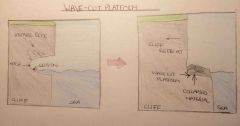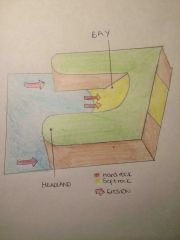![]()
![]()
![]()
Use LEFT and RIGHT arrow keys to navigate between flashcards;
Use UP and DOWN arrow keys to flip the card;
H to show hint;
A reads text to speech;
4 Cards in this Set
- Front
- Back
|
How is a Wave-Cut Platform formed? |

1) Erosion occurs near the base of the cliff.
2) A Wave-Cut Notch is formed with unstable rock above it.
3) With further erosion the unstable rock collapses and falls onto the platform below.
4) The collapsed material is carried away and a new notch is formed.
5) Repetition of the process repeats and a Wave-Cut Platform is formed as the cliff retreats. |
|
|
How do Headlands and Bays form? |

Some rock is more easy to eroded than others.
Headlands form when there are alternating bands of soft and hard rock along the coast.
The soft rock ie. Limestone and clay, is easy to eroded and so retreats faster than hard rock forming a bay. Bays have slumps at the base. Whilst the hard rock such as chalk is more corrosion resistant and so doesn't retreat as quickly making it stick out next to a bay, headlands have very steep sides. |
|
|
How are beaches formed? |
Beaches are formed by constructive waves depositing material at the base of a cliff. They form between the high water mark and low water mark of the ocean on the coast. |
|
|
How are Spits and Bars formed? |
P |

